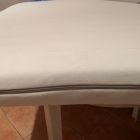Underground discovery at the Vittoriano.
Having seen a two-line mention in a Rome daily, and wondering whether a visit would amuse my seven-year-old grandson during the semi-closure of Rome in August, we set off for the Vittoriano, otherwise known as Altare della Patria, wedding cake and typewriter among its other nicknames at Piazza Venezia.
Love it or hate it, its gigantic size and the glaring whiteness of its Brescian marble make it one of the most well-known landmarks in Rome, blending little with the mellow tones of most of the buildings in the rest of the city. Back in the 1950s, H.V. Morton pointed it out in his memorable A Traveller in Rome as one of the few places in Rome where you cannot be run over.
The idea for the monument was conceived in 1878 to commemorate the recent unification of Italy and to honour her first king, Vittorio Emanuele II, who had died a short while earlier. Following the submission of over 400 projects in response to two public competitions, that of architect Giuseppe Sacconi was finally selected, loosely based on the Acropolis at Athens and the Altar of Zeus at Bergama in Turkey.
Detailed scale models were prepared by Sacconi in 1885 but after his death in 1905, the monument was partially redesigned by Gaetano Koch, Manfredo Manfredi and Pio Piacentini on a somewhat reduced scale, before finally being inaugurated by Vittorio Emanuele III in 1911. The choice of the site led to fierce opposition since huge chunks of ancient and mediaeval Rome had to be destroyed, including the Ara Coeli convent, the tower of Paolo III, the house of Michelangelo and Pietro da Cortonas studio. Other possible sites such as the Pincio, near Piazza del Popolo, and the Termini railway station area, where other vast tracts of ancient Rome were being bulldozed, were rejected for one reason or another and Agostino Depretis, prime minister at the time, insisted that the memorial be erected in the very heart of ancient Rome, next to the Campidoglio. After world war one, the tomb of the Unknown Soldier was placed beneath the equestrian statue of Vittorio Emanuele II and the monument became known as the Altar of the Homeland.
A few years ago an exploration was made of the foundations, which rest on vast brick vaults and the remains of ancient Roman quarries of tufa rock. Here, in the labyrinth of tunnels and passages where you can clearly see the marks of Roman quarrying tools, an air-raid shelter was established during the last war, complete with electricity, drinking water and a first-aid centre. Graffiti on the brickwork reads i gatti neri sono velocissimi (the black cats are very fast), a reference to the firemen of the period who wore black uniforms. At one point part of an abandoned tunnel is still visible, where obviously two teams of ancient Roman workmen failed to meet up with each other.
To my grandsons delight, we were made to don yellow protective helmets, and set off with our excellent guide along the dimly-lit tunnels, being warned to keep close and always to make sure we turned right to avoid getting lost (which added to the thrill). A passageway has been discovered which runs as far as Palazzo Venezia, and it is believed there are further passages leading all the way to Piazza del Popolo, yet to be explored.
It is now possible to visit the upper terraces of the monument, which were closed until a few years ago, from which one has a superb view of the surrounding areas of the city (entrance at present is through a gate in the iron grille at the front of the monument, open daily 09.30-17.30). We climbed up to the top and stood under the huge equestrian statue of Vittorio Emanuele II, inside which 21 people are said to have dined by the light of oil lamps when it was inaugurated. It weighs 50 tons, is 16 times larger than life, and each hoof measures over half a metre in diameter. Dozens of well-known sculptors and artists of the period, too numerous to mention here, contributed allegorical statues, friezes and fountains to the decorations, while the mosaics above the upper terrace were designed by Antonio Ricci and Giulio Bargellini.
On the right-hand side of the monument (looking from Piazza Venezia) is an entrance marked Istituto per la storia del Risorgimento Italiano. This is also the entry to the underground excavations (see below).
On the left-hand side of the monument, at street level, is the Sacrario delle Bandiere, where over 200 military and naval flags and their beautifully-carved boxes are on display, as well as an entire MAS 15 torpedo boat from world war one, Il Maiale an underwater assault craft from the second world war and other mementoes. This is also well worth a visit. (Tues-Sun 09.30-17.00, Mon closed).
The Vittoriano also contains the Museo Centrale del Risorgimento (not to be confused with Istituto per las storia del Risorgimento Italiano) with its entrance also on the right of the monument (looking from Piazza Venezia); but this is more likely to appeal to older children. (Daily 09.30-18.00).
At present there are guided visits to the underground foundation area every day 11.00-12.00, and again 16.00-17.00 (not, as stated in the papers, all day between 09.30-18.00, when only the exhibition area of the monument can be visited). The ticket office, gathering point for tours and a display of the original scale models, can be reached through the entrance on right-hand side of the monument (the same entrance as the Istituto per la storia del Risorgimento Italiano). During our visit an English-speaking guide was on hand as well as an Italian-speaking guide, and it is hoped that the visits will continue at least until the end of September, depending on public interest.
For more information on the underground tours tel. 0669202049.

















